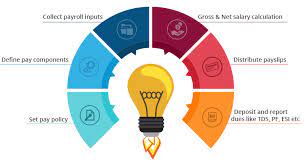
A payroll policy is a set of guidelines, rules, and procedures that an organization establishes to govern how it manages employee compensation, including salaries, wages, and benefits. These policies help ensure that the payroll process is fair, transparent, and compliant with legal and regulatory requirements. Here are some key elements typically included in a payroll policy:
Compensation Structure: Define how employees are compensated, including salary levels, hourly wages, bonuses, and any other forms of compensation.
Payroll Schedule: Specify how often employees are paid (e.g., weekly, bi-weekly, monthly) and the paydays. Ensure that the schedule complies with labor laws and regulations.
Payroll Processing: Outline the procedures and timelines for processing payroll, including the submission of timesheets, approval processes, and deadlines for changes.
Deductions and Taxes: Explain how deductions for taxes, benefits, and other withholdings are handled, ensuring compliance with local, state, and federal tax laws and regulations.
Overtime and Leave Policies: Detail the rules for overtime pay, as well as how different types of leave (sick leave, vacation, holidays) are managed and compensated.
Benefits and Perks: Describe any additional benefits and perks provided to employees, such as healthcare, retirement plans, and other fringe benefits.
Record Keeping: Specify the retention and record-keeping requirements for payroll data, including employee earnings, tax documents, and pay stubs.
Payment Methods: Explain how employees receive their pay, whether through direct deposit, physical checks, or other means.
Reporting and Compliance: Address how the organization complies with local, state, and federal labor laws and tax regulations, and outline procedures for reporting and compliance audits.
Payroll Discrepancies and Disputes: Provide a process for employees to address and resolve payroll-related discrepancies or disputes.
Confidentiality: Emphasize the importance of maintaining the confidentiality of payroll information to protect employees’ privacy.
Communication: Explain how employees will be informed of any changes to the payroll policy or their compensation.
Training: Ensure that payroll staff and relevant personnel receive proper training to execute the policy correctly.
Governance: Designate responsibility for overseeing payroll administration and compliance, including the roles of payroll administrators and HR personnel.
Legal Compliance: Stay up-to-date with and adhere to labor laws, tax codes, and other relevant regulations to ensure legal compliance.
It’s important to note that payroll policies can vary significantly from one organization to another, depending on factors such as company size, industry, and geographic location. It’s essential for companies to regularly review and update their payroll policies to stay in compliance with changing laws and to meet the evolving needs of their workforce.
Data Type Checking: Ensure that the input data matches the expected data type. For example, if a field expects a date, it should reject non-date values.
Range and Boundary Checks: Verify that the input falls within acceptable ranges. For example, if a user is asked to enter their age, it should be a positive integer within a reasonable range.
Format and Pattern Matching: Check if the input data conforms to a specified format or pattern. For instance, an email address should match a standard email format.
Length Validation: Ensure that the length of the input data, such as text or passwords, falls within acceptable limits. This helps prevent buffer overflows and data truncation.
Whitelist Validation: Define a whitelist of acceptable characters and reject any input containing characters not on the whitelist. This helps protect against SQL injection, cross-site scripting (XSS), and other security vulnerabilities.
Blacklist Validation: Define a blacklist of disallowed characters or patterns and reject any input containing them. This can help prevent common security attacks, but it’s generally less secure than whitelisting.
Data Validation at Multiple Layers: Implement input validation at various layers of your application, including the client side (e.g., in web forms using JavaScript) and the server side, to provide defense in depth.
Sanitization: For certain types of data, like HTML or SQL, consider sanitizing the input to remove potentially harmful elements or characters. However, this should be a secondary measure after validation.
Parameterized Queries: When dealing with databases, use parameterized queries or prepared statements to prevent SQL injection attacks.
Error Handling: Implement proper error handling for input validation failures, providing informative error messages without disclosing sensitive information.
Secure File Uploads: If your application allows file uploads, validate file types and use server-side checks to ensure uploaded files are safe and do not contain malicious code.
Regular Updates: Keep your input validation rules up-to-date, as security threats and application requirements change over time.
Testing: Thoroughly test your input validation mechanisms through various scenarios, including valid and invalid inputs, to ensure they work as expected.
Input validation is a fundamental part of building secure and reliable software. Failing to validate input data can lead to various vulnerabilities, such as injection attacks, data breaches, and application crashes. Therefore, it’s essential to incorporate input validation as a best practice in your software development process to enhance the security and integrity of your applications.






